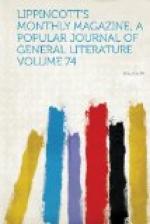The bonnet was black velvet, and we were in midsummer. The material, however, was skillfully draped with a veil, and a profusion of pink flowers gave it a seasonable air. A crimson bow was also tied at her neck; she complacently remarked that “pink and crimson harmonize beautifully;” and others of the party arriving at that moment, I was saved the trouble of making a polite answer.
The ride through ripening grain-fields and moss-thatched hamlets need not be described; suffice it to say, it was France and June. An omnibus was waiting at the station where we dismounted: it carried us near, but not to, our destination. After leaving it we walked through the streets of a low-roofed village, then followed a path bordered with wild mignonette and apple trees that wound up the side of a hill covered with vineyards. A couple of chattering magpies ran before us, an invisible cuckoo was heard between snatches of Italian melody warbled by the tenor sotto voce and the little company overflowed with gayety.
The house we arrived at looked as if it might be a castle in the air materialized—pointed windows hidden in ivy, through which you saw the chintz-covered walls of the interior; turrets on the roof and a stair-tower; odd nooks for pigeons and cattle; the color a weather-toned red, met by gray roofs, green trees and blue sky. We passed through it to the quaint garden: rows of dwarf pears bordered its paths, and trellises and walls supported nectarines and vines, with sunshine and shadow caressing the half-ripe fruit.
The shady spaces were occupied by guests who had arrived before us, and we saw with pleasure that ceremony had not been invited to attend. The host’s kindly manner was sufficient to put the company at once at ease. We wandered at will from group to group, listening or conversing: introductions were sometimes given, but more often not.
At one table some ladies and gentlemen were playing the artistic game of “five points.” A more difficult pastime was never invented. The materials necessary are simply a piece of paper and a pencil: it is their use that is extraordinary. A person puts five dots on the paper in whatever position fancy may dictate: on this slight foundation another is expected to design a figure, the puzzle being to include all the marks given. One that I saw had four of the dots placed unusually close together, and the fifth in a distant corner: this latter, in the opinion of the lookers-on, would surely prove refractory. After some moments of consideration, with pencil suspended and eye attentive, the artist commenced drawing. In ten minutes the sketch was finished. It was an angel: her upturned head took in the highest of the group of dots; one hand hanging by her side the next; a knee the third; and the flowing hem of her robe the fourth; but the fifth in the corner—what could reach it? With a touch of the pencil the angel’s other hand appeared flinging up a censer attached to




